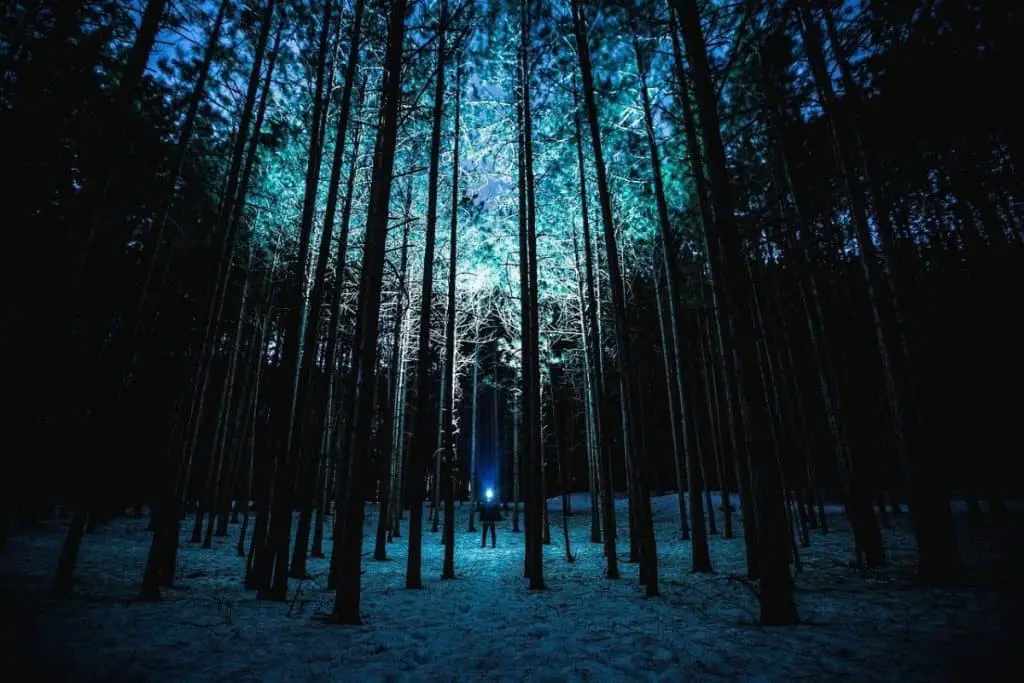While most people just use a regular flashlight without filters, there are specific situations where it makes more sense to have a colored filter or lens to change the color of the light. Blue flashlight lenses and red flashlight lenses are the most common, but green is also sometimes used.
Colored flashlight lenses are used for specialized tasks in low or no light conditions. Blue, red, and green preserve night vision. Blue highlights blood, and also helps with some fishing, red gives good vision for hiking, hunting, or military use without ruining night vision, while green is a balance between the two.

Most individuals outside the military or very specialized professions won’t need one. But there are some who will.
And there are some good reasons why avid outdoor enthusiasts may choose to want to have that option on hand.
What Are Blue Light Flashlight Lenses For?
Blue light is one of the shades of light that does less damage to night vision while also providing benefits in some specific instances.
Tactically, blue torch light is useful in spotting blood or giving medical assistance in unlit isolated areas at night. This is because blue light gives a bit of a luminescence to blood, making it much easier to spot.
Blue light allows for map reading at night, especially maps with red lines which turn invisible under red light. From a practical standpoint this can be good for night hiking, night tactical exercises in the military, or pilots.
Blue light also has the specific trait of being the only light that cuts through fog. This makes it extremely popular for headlights or for use in extremely foggy terrain (hello wildlife biologists on the coast of Maine).
Blue light filters are good for:
- Locating blood or other bodily fluids at crime scenes
- Cutting through foggy weather
- Tracking blood as a hunter
- Reading maps at night
- Help light up area for night fishing (with certain fish)
What Are Red Light Flashlight Lenses For?
Red light is useful for multiple reasons however it’s really important to know there’s a caveat with this one.
Red light is great for use to illuminate an area without ruining night vision in the human eye. I’m not a science major, but here’s a great article from the National Park Service on how that works if you do want to know the science behind it.
Red lights are great for lighting up an area without breaking your night vision. This makes them a good choice for night hunting, hiking, or making your way around a campsite without using a bright white light lantern that may wake up everyone in the area.
This is because red light is gentler on the human eye than conventional white light.
Shadows can deepen a bit with red light, so it’s still important to make sure you are moving with caution when going out and about.
Caveat on red light flashlights: Red light is a universal signal for distress so having an-ongoing red light like from a lantern in an isolated area is not a good idea unless you actually NEED rescue.
Red light filters are good for:
- Accentuating night vision
- Lighting up an area for night hunting or hiking without ruining your night vision
- Lighting up an area without giving away your position
What About Other Flashlight Colors?
Generally blue or red will be the best option if you need something other than conventional white light for your flashlight. Green is a good compromise color.
It gives many of the benefits of blue light or red light though not necessarily to the same extent. You do have better night vision, and there are many hunters who actually swear that green light is the best because it doesn’t scare off or alarm animals.
This is anecdotal evidence, but there is a LOT of it.
Green light won’t give the full detail or range of vision as red light or blue light, but you won’t be accidentally signaling for rescue and if you’re hunting at night this can give you the edge you need to fill out those tags.
Green light does tend to run a bit longer than blue or red, assuming you’re using lights and not a filters. Which is also a nice bonus.
Green light filters for flashlights are good for:
- Night hunting without scaring animals
- Compromise from blue or red light options
Do You Need A Colored Flashlight Lens?
Most people won’t necessarily need a blue light flashlight, red light flashlight, or green light flashlight. Whether the light itself or a filter, most people probably don’t need these.
However, if you have an active outdoor lifestyle at night whether recreationally or because of work, then having these on hand is a good idea.
Better to have and not need than to need and not have, right?
Great beginning red light flashlight!
Flashlight Versus Flashlight Lens
Basically there are two ways to get these colored torch lights. One is buying a specialty light. Some are just designed to be red light flashlights or blue light flashlights.
That is a bit more uncommon but with a little bit of looking around it’s not hard to find these.
Then there’s the slightly more common solution of getting attachable lenses or “filters” that are blue, red, green, or whatever color you want the illumination from your flashlight to be.
In Conclusion
I have a blue lens, red lens, and green lens for my two main flashlights because I just like being prepared. There was a time in my life I did a lot of night hiking, and it was nice knowing I had options although truth be told, many times I just used the regular light.
Knowing what blue light does versus red light versus regular light from your flashlight will help you make a decision on what options are going to be right for you.
